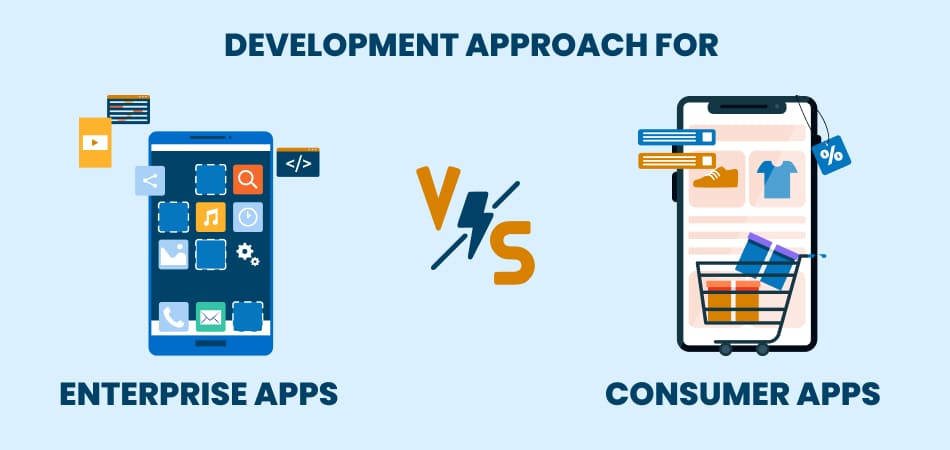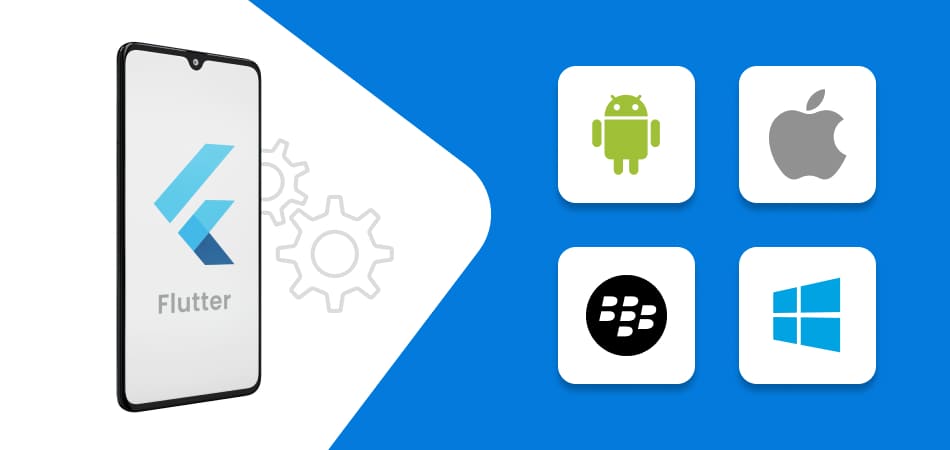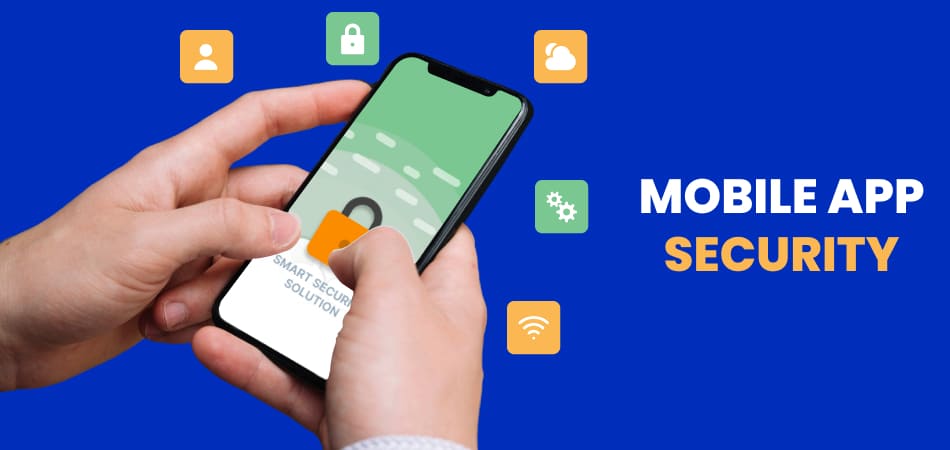Not all mobile applications serve the same purpose, and understanding the key distinctions between enterprise and consumer mobile apps is crucial. While enterprise apps focus on efficiency, security, and seamless business integration, consumer apps prioritize user engagement, intuitive design, and mass-market appeal. For developers, these differences shape everything—from design choices to security protocols and scalability strategies. Whether you’re building an enterprise tool that streamlines workflows or a consumer app that captivates millions, applying the right development approach is key to success.
What Are Enterprise Apps?
Enterprise mobile applications are designed specifically for business use, enabling organizations to automate processes, improve productivity, and facilitate collaboration on mobile devices. These apps often handle large volumes of data and integrate with existing enterprise systems such as Customer Relationship Management (CRM), Enterprise Resource Planning (ERP), and Human Resource Management Systems (HRMS). Examples include Microsoft Teams, Salesforce Mobile, and Workday.
What Are Consumer Apps?
Consumer mobile applications cater to the general public, providing solutions for entertainment, social interactions, personal finance, and lifestyle management. These apps are designed with a user-first approach, prioritizing engagement, ease of use, and appealing aesthetics. Examples include Instagram, Spotify, and Uber.
Key Differences Between Enterprise and Consumer Apps
| Aspect | Enterprise Apps | Consumer Apps |
| Target Audience | Built for businesses and organizations that often require role-based access and hierarchical permissions. | Built for individual users, focusing on personal convenience, entertainment, and engagement. |
| Purpose & Functionality | The objective is to optimize business operations, support workflow automation, and improve efficiency. | The objective is to enhance user experience, convenience, and engagement through features like social sharing and gamification. |
| Design & User Experience | Based on functionality and efficiency over aesthetics; interfaces may be complex due to the nature of business operations. | Based on delivering an intuitive, visually appealing, and engaging user interface to maximize user retention. |
| Security Requirements | Robust security measures such as data encryption, multi-factor authentication, and strict access controls are required. | Security is important but often balanced with user convenience, ensuring smooth authentication processes. |
| Scalability & Performance | Handling large-scale operations, ensuring high availability, redundancy, and data consistency are must-have functions. | Need to scale dynamically based on user demand, especially for viral applications with unpredictable growth. |
Development Approach for Enterprise Apps

Enterprise applications require a structured and strategic development approach due to their critical role in business operations. Unlike consumer apps, where user engagement is a priority, enterprise apps must prioritize security, integration, scalability, and long-term usability. Seamless integration with enterprise systems, and maintaining compliance with strict security regulations take priority, which necessitates the following approach:
-
Close Collaboration with Business Stakeholders
Developers must work hand-in-hand with business leaders to gather detailed requirements, understand operational workflows, and ensure alignment with business goals.
-
Seamless System Integration
Enterprise mobile apps must integrate smoothly with existing enterprise software like CRM, ERP, and HRMS, enabling efficient data exchange and workflow automation.
-
Robust Security Measures
Given the sensitive nature of enterprise data, strong security protocols such as encryption, multi-factor authentication, role-based access controls, and compliance with regulations like GDPR and HIPAA are essential.
-
Optimized Performance Across Devices
Enterprise apps need to function seamlessly across various mobile devices, operating systems, and screen sizes while maintaining high performance.
-
Comprehensive Training and Support
Since enterprise mobile apps are used by employees with varying levels of technical expertise, companies must offer training programs and ongoing technical support to ensure smooth adoption and efficient use.
Development Approaches for Consumer Apps
Consumer applications, on the other hand, are designed to engage and retain users while providing seamless, enjoyable experiences. The development approach for these apps focuses on market trends, intuitive design, agile development, and performance optimization. Consumer apps must also focus on monetization strategies and virality to drive growth. All that makes the development approach to consumer apps different from that of enterprise apps.
-
In-Depth Market Research
Understanding user behavior, demographics, and market trends is essential. Developers must conduct competitive analysis, analyze user preferences, and identify pain points to build an app that stands out in the crowded consumer market.
-
User-Centric UI/UX Design
Consumer mobile apps must prioritize a visually appealing, intuitive interface that enhances user engagement. Features like easy navigation, smooth animations, and personalized experiences help improve user satisfaction and retention.
-
Agile Development and Rapid Iteration
Consumer preferences change quickly, requiring developers to adopt agile methodologies. Frequent updates, quick bug fixes, and iterative improvements based on real-time user feedback are necessary for staying competitive.
-
Optimized Mobile Performance
Speed and responsiveness play a major role in user retention. Developers must ensure fast load times, smooth transitions, and responsiveness across various mobile devices and operating systems.
-
Effective Monetization Strategies
Revenue generation is a crucial aspect of consumer mobile apps. Developers can implement strategies such as freemium models, in-app purchases, subscriptions, advertisements, or sponsored content to drive profitability while maintaining a positive user experience.
Development Challenges and Considerations

Developing applications, whether for enterprises or consumers, comes with unique challenges and considerations. Each type of application has distinct requirements, from security and compliance in enterprise apps to user engagement and monetization in consumer apps. Developers must navigate these complexities while ensuring optimal performance, scalability, and user experience.
Challenges and Considerations for Enterprise App Development

- Enterprise mobile applications must adapt to changing business needs, requiring scalable and modular development approaches.
- Developers must ensure compliance with industry standards such as GDPR and HIPAA, enforcing strict security policies for mobile devices.
- Seamless data flow between multiple enterprise systems is crucial for operational efficiency.
- While enterprise mobile apps prioritize functionality, an intuitive mobile-friendly UI is still essential for user adoption.
- Must support large-scale mobile operations, requiring robust infrastructure and load-balancing mechanisms.
Challenges and Considerations for Consumer App Development
- Developers must continuously innovate to keep users engaged through new features and improvements.
- Protecting user data while maintaining ease of access is a critical challenge.
- Ensuring a seamless experience across various mobile devices, operating systems, and screen sizes is a must-have.
- Ensure optimizing speed and responsiveness to prevent user churn.
- Finding the right balance between revenue generation and user experience is crucial.
Apps that the Developers Consider Best-in-Class
One of the Most Loved Enterprise Apps—Slack

Slack is a widely used enterprise communication and collaboration tool that has transformed how teams interact in real time. Designed for businesses of all sizes, Slack facilitates seamless communication through messaging, file sharing, integrations, and automation. Its mobile application is essential for ensuring productivity and connectivity among remote and hybrid teams.
Development Approach behind Slack
Slack’s development approach focuses on delivering a highly functional, secure, and scalable mobile experience tailored for enterprise communication. By integrating with business tools, prioritizing security, and continuously optimizing performance, Slack has become a go-to enterprise mobile app for organizations worldwide.
- Designed for Business Productivity
Slack’s mobile app prioritizes a simple yet powerful user interface to streamline communication. The development team focused on intuitive navigation, ensuring employees can quickly access messages, channels, and integrations with minimal learning curve. Features like push notifications, message threading, and quick search enhance efficiency for mobile users.
- Seamless Integration with Enterprise Tools
Slack was built with an API-first approach, allowing easy integration with enterprise tools like Google Drive, Microsoft Office 365, Salesforce, and Jira. The development team ensured that Slack could act as a centralized hub where employees can collaborate without switching between multiple applications.
- Scalability and Real-Time Performance Optimization
Slack’s architecture was designed to handle millions of simultaneous interactions, making it highly scalable for enterprises of all sizes. Developers used WebSockets and optimized backend systems to support real-time messaging without lag. Performance testing ensured smooth operation on mobile devices, even in areas with limited internet connectivity.
- Enterprise-Grade Security and Compliance
Slack incorporated robust security measures, including end-to-end encryption, multi-factor authentication, and role-based access controls. Compliance with industry standards like GDPR, SOC 2, and HIPAA was prioritized to meet enterprise security needs. Developers implemented mobile-specific security features such as biometric authentication and remote session management to safeguard sensitive data.
- Continuous Improvement with Agile Development
Slack’s development team follows an Agile methodology, frequently releasing updates based on user feedback. A/B testing and user analytics are used to refine features, ensuring the app meets the evolving needs of business users. Regular performance optimization ensures the mobile experience remains fast and responsive.
One of the Cleanest and Engaging Consumer Apps—Uber
Uber is one of the world’s most recognized consumer mobile apps, revolutionizing the ride-hailing industry by connecting riders with drivers in real time. The app provides a seamless and convenient transportation solution, leveraging GPS, AI-driven matching, and a frictionless payment system. Uber’s development approach prioritizes scalability, real-time responsiveness, and an intuitive user experience to cater to millions of users worldwide.
Development Approach behind Uber
Uber’s development approach focuses on creating a frictionless, high-performance mobile experience by leveraging real-time data, cloud scalability, and AI-driven optimizations. By continuously improving UI/UX, security, and efficiency, Uber remains a dominant player in the consumer mobile app market.
- User-Centric and Intuitive UI/UX Design
Uber’s mobile app is designed with a simple and visually appealing interface to ensure ease of use. Key features like one-tap ride booking, estimated fare calculation, and real-time tracking improve user engagement. The development team optimized the app for different screen sizes and devices to maintain a consistent experience across platforms.
- Real-Time Data Processing and Location Services
Uber’s app relies on real-time GPS tracking and mapping technologies to match riders with nearby drivers efficiently. Developers used WebSockets and push notifications to provide instant updates on ride status, driver location, and estimated arrival times. Background location tracking was optimized to reduce battery drain while maintaining accuracy.
- Scalable Cloud-Based Infrastructure
Uber’s backend is built on a microservices architecture, allowing seamless scalability as user demand fluctuates. The app leverages cloud computing services (AWS, Google Cloud) to process millions of ride requests per second. Load balancing and caching mechanisms ensure fast response times, even during peak hours.
- Secure and Seamless Payment System
Uber integrates multiple payment gateways, supporting credit cards, digital wallets, and local payment methods across different regions. Security measures such as tokenization and encryption protect users’ financial information. Developers implemented a fraud detection system using AI to flag suspicious transactions and prevent unauthorized access.
- Data-Driven Iterations and Agile Development
Uber’s development team continuously analyzes user behavior and ride patterns to optimize app performance. A/B testing is used to refine new features, such as ride-sharing options and pricing models. Frequent updates ensure the app evolves with changing user needs, regulatory requirements, and technological advancements.
Conclusion
Enterprise and consumer mobile apps serve distinct purposes, and developers must tailor their approaches accordingly. Enterprise apps demand strong security, seamless system integration, and high scalability, while consumer apps require engaging UI/UX, fast performance, and effective monetization strategies. By understanding these differences and applying the right development methodologies, developers can build high-impact mobile applications that drive business growth and enhance user experiences.




